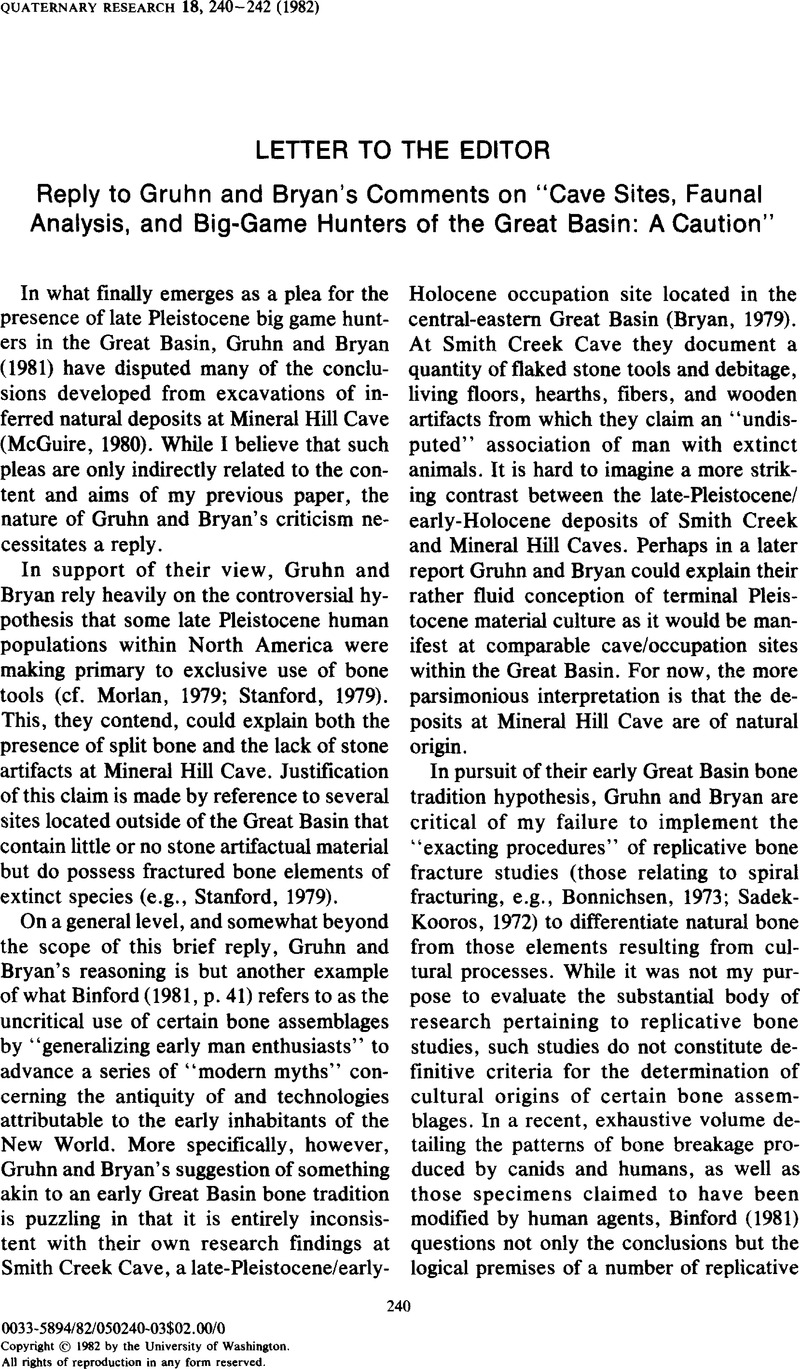No CrossRef data available.
Article contents
Reply to Gruhn and Bryan's Comments on “Cave Sites, Faunal Analysis, and Big-Game Hunters of the Great Basin: A Caution”
Published online by Cambridge University Press: 20 January 2017
Abstract
An abstract is not available for this content so a preview has been provided. Please use the Get access link above for information on how to access this content.

- Type
- Reply to the Editor
- Information
- Copyright
- University of Washington
References
Baumhoff, M.A.
Heizer, R.F. (1970). Big-Game Hunters of the Great Basin: A critical review of the evidence. University of California Archaeological Research Facility Contributions
7. 1–12.Google Scholar
Bonnichsen, R. (1973). Some operational aspects of human and animal bone alteration. Mammalian Osteo-Archaeology: North America. Gilbert, B.M.
Missouri Archaeological Society, University of Missouri, Columbia. 9–26.Google Scholar
Brain, C.K. (1967). Bone weathering and the problem of pseudo-tools. South African Journal of Science
63. 97–99.Google Scholar
Bryan, A.L. (1979). Smith Creek Cave
The Archaeology of Smith Creek Canyon, Eastern Nevada. Nevada State Museum Anthropological Papers. Touhy, D.R.
Randall, D.L.
17. 162–253.Google Scholar
Cressman, L.S. (1946). Studies of early man in south-central Oregon. Carnegie Institute of Washington Yearbook
39. 300–306.Google Scholar
Cressman, L.S. (1966). Man in association with extinct fauna in the Great Basin. American Antiquity
31. 866–867.CrossRefGoogle Scholar
Gifford, D.P. (1981). Taphonomy and paleoecology: A critical review of archaeology's sister disciplines. Advances in Archaeological Method and Theory. Schiffer, M.B.
Vol. 4. Academic Press, New York.Google Scholar
Gruhn, R. (1961). The archaeology of Wilson Butte Cave, south-central Idaho. Occasional Papers of Idaho State Museum
6.Google Scholar
Gruhn, R.
Bryan, A.L. (1981). A response to McGuire's cautionary tale about the association of Man and extinct fauna in the Great Basin. Quaternary Research
16. 117–121.Google Scholar
Guthrie, R.O. (1980). Review of “Pleistocene Bone Technology in the Bering Refugium,” by R. Bonnichsen. The Quarterly Review of Archaeology
1.Google Scholar
Harrington, M.R. (1934). American horses and ancient men in Nevada. Southwest Museum Masterkey
8. 165–169.Google Scholar
Haynes, C.V. (1974). Paleoenvironments and cultural diversity in late Pleistocene South America: A reply to A. L. Bryan. Quaternary Research
4. 378–382.Google Scholar
McGuire, K.R. (1980). Cave sites, faunal analysis, and big-game hunters of the Great Basin: A caution. Quaternary Research
14. 263–268.Google Scholar
Morlan, R.E. (1979). A stratigraphic framework for Pleistocene artifacts from Old Crow River, northern Yukon territory. Pre-Llano Cultures of the Americas: Paradoxes and Possibilities. Humphrey, R.L.
Stanford, D.
Anthropological Society of Washington, Washington, D.C. 125–145.Google Scholar
Myers, P.M.
Voorhies, M.
Corner, R.G. (1980). Spiral fractures and bone pseudotools at paleontological sites. American Antiquity
45. 483–489.Google Scholar
Orr, P.C. (1956). Pleistocene Man in Fishbone Cave, Pershing County, Nevada. Nevada State Museum Bulletin
2.Google Scholar
Sadek-Kooros, H. (1966). Jaguar Cave: An Early Man Site in the Beaverhead Mountains of Idaho. Ph.D. dissertation
Harvard University, Cambridge, Mass.Google Scholar
Sadek-Kooros, H. (1972). Primitive bone fracturing: A method research. American Antiquity
37. 369–382.Google Scholar
Shutler, R. (1961). Correlation of beach terraces with climatic cycles of Pluvial Lake Lahontan, Nevada. Annals of the New York Academy of Sciences
95. 513–520.Google Scholar
Stanford, D. (1979). The Selby and Dutton sites: Evidence for a possible pre-Clovis occupation of the High Plains. Pre-Llano Cultures of the Americas: Paradoxes and Possibilities. Humphrey, R.L.
Stanford, D.
Anthropological Society of Washington, Washington, D.C. 101–123.Google Scholar


